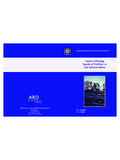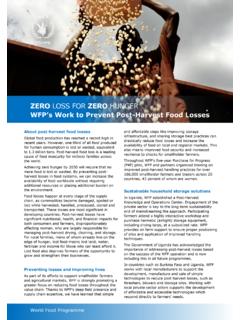Transcription of Save and grow - Food and Agriculture Organization
1 save and growA policymaker s guideto the sustainable intensificationof smallholder crop productionFOOD AND Agriculture Organization OF THE UNITED NATIONSRome, 2011 Reprinted 2011, 2012, 2013 The designations employed and the presentation of material in this information product do not imply the expression of any opinion whatsoever on the part of the Food and Agriculture Organization of the United Nations (FAO) concerning the legal or development status of any country, territory, city or area or of its authorities, or concerning the delimitation of its frontiers or boundaries. The mention of specific companies or products of manufacturers, whether or not these have been patented, does not imply that these have been endorsed or recommended by FAO in preference to others of a similar nature that are not 978-92-5-106871-7 All rights reserved.
2 FAO encourages reproduction and dissemination of material in this information product. Non-commercial uses will be authorized free of charge, upon request. Reproduction for resale or other commercial purposes, including educational purposes, may incur fees. Applications for permission to reproduce or disseminate FAO copyright materials, and all queries concerning rights and licences, should be addressed by e-mail to or to the Chief, Publishing Policy and Support Branch, Office of Knowledge Exchange, Research and Extension, FAO, Viale delle Terme di Caracalla, 00153 Rome, Italy. FAO 2011 Foreword With the publication of save and grow in 2011, FAO proposed a new paradigm of intensive crop production, one that is both highly productive and environmentally sustainable.
3 FAO recognized that, over the past half-century, Agriculture based on the intensive use of inputs has increased global food production and average per capita food consumption. In the process, however, it has depleted the natural resources of many agro-ecosystems, jeopardizing future productivity, and added to the greenhouse gases responsible for climate change. Moreover, it has not significantly reduced the number of chronically hungry, which is currently estimated at 870 million challenge is to place food production and consumption on a truly sustainable footing. Between now and 2050, the global popula-tion is projected to rise from about 7 billion to billion, demanding if current trends continue a 60 percent increase in global food production.
4 Given the diminishing area of unused land with good agricultural potential, meeting that demand will require ever higher crop yields. Those increases, in turn, need to be achieved in the face of heightened competition for land and water, rising fuel and fertilizer prices, and the impact of climate and grow addresses the crop production dimension of sustain-able food management. In essence, it calls for greening the Green Revolution through an ecosystem approach that draws on nature s contributions to crop growth, such as soil organic matter, water flow regulation, pollination and bio-control of insect pests and diseases.
5 It offers a rich toolkit of relevant, adoptable and adaptable ecosystem-based practices that can help the world s 500 million smallholder farm families to achieve higher productivity, profitability and resource use efficiency, while enhancing natural capital. This eco-friendly farming often combines traditional knowledge with modern technologies that are adapted to the needs of small-scale producers. It also encourages the use of conservation Agriculture , which boosts yields while restoring soil health. It controls insect pests by protecting their natural enemies rather than by spraying crops indiscriminately with pesticides.
6 Through judicious use of mineral fertilizer, it avoids collateral damage to water quality. It uses preci-sion irrigation to deliver the right amount of water when and where it is needed. The save and grow approach is fully consistent with iv save and Growthe principles of climate-smart Agriculture it builds resilience to climate change and reduces greenhouse gas emissions through, for example, increased sequestration of carbon in soil. For such a holistic approach to be adopted, environmental virtue alone is not enough: farmers must see tangible advantages in terms of higher incomes, reduced costs and sustainable livelihoods, as well as compensation for the environmental benefits they generate.
7 Policymakers need to provide incentives, such as rewarding good management of agro-ecosystems and expanding the scale of pub-licly funded and managed research. Action is needed to establish and protect rights to resources, especially for the most vulnerable. Developed countries can support sustainable intensification with relevant external assistance to the developing world. And there are huge opportunities for sharing experiences among developing coun-tries through South-South Cooperation. We also need to recognize that producing food sustainably is only part of the challenge.
8 On the consumption side, there needs to be a shift to nutritious diets with a smaller environmental footprint, and a reduction in food losses and waste, currently estimated at almost billion tonnes annually. Ultimately, success in ending hunger and making the transition to sustainable patterns of production and consumption requires transparent, participatory, results-focused and accountable systems of governance of food and Agriculture , from global to local levels. This third reprint of save and grow comes following the Rio+20 Conference in June 2012 and the launch of the Zero Hunger Chal-lenge by the United Nations Secretary-General, Ban Ki-moon.
9 The challenge has five elements: guarantee year-round access to adequate food, end stunting in children, double small farmer productivity, fos-ter sustainable food production systems, and reduce food waste and loss to zero. In assisting countries to adopt save and grow policies and approaches, FAO is responding to that challenge and helping to build the hunger-free world we all want. Jos Graziano da SilvaDirector-GeneralFood and Agriculture Organizationof the United NationsContentsForeword iiiAcknowledgements viOverview viiChapter 1: The challenge 1 Chapter 2: Farming systems 15 Chapter 3: Soil health 27 Chapter 4: Crops and varieties 39 Chapter 5: Water management 51 Chapter 6: Plant protection 65 Chapter 7: Policies and institutions 77 Sources 95 Abbreviations 102vi save and GrowThis book was produced under the direction of Shivaji Pandey, Director of FAO s Plant Production and Protection Division.
10 Guidance was provided by a steering committee and a technical advisory group. Final technical editing was done by Mangala Rai (President of the National Academy of Agricultural Sciences, India), Timothy Reeves (former Director-General of the International Maize and Wheat Improvement Center), and Shivaji authors:Linda Collette (FAO), Toby Hodgkin (Bioversity International), Amir Kassam (University of Reading, UK), Peter Kenmore (FAO), Leslie Lipper (FAO), Christian Nolte (FAO), Kostas Stamoulis (FAO), Pasquale Steduto (FAO)Collaborators:Manuela Allara (FAO), Doyle Baker (FAO), Hasan Bolkan (Campbell Soup Co.)











